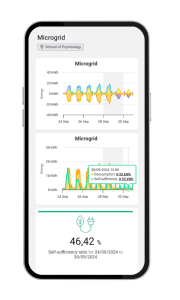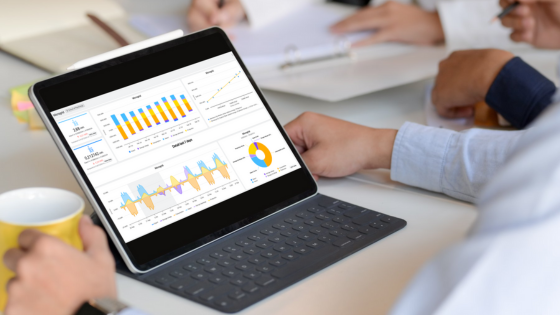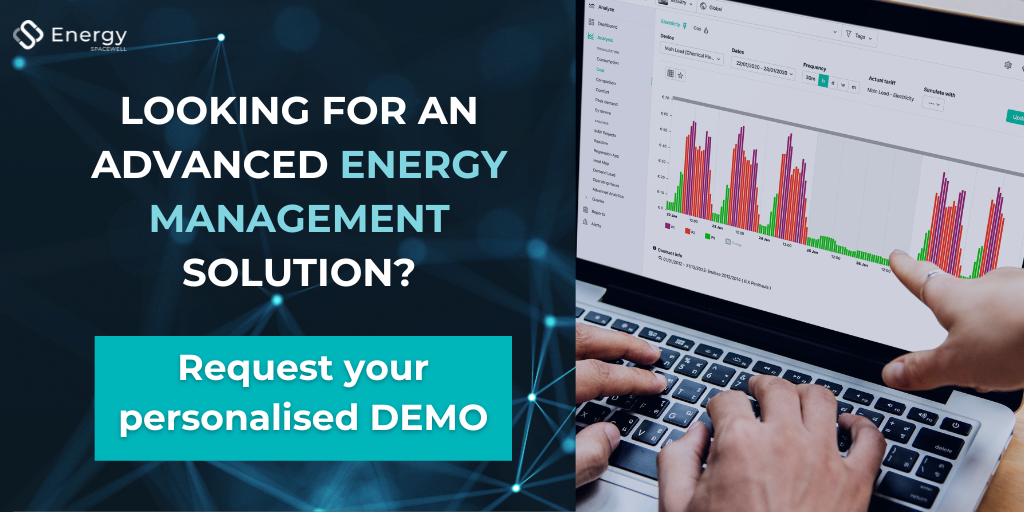Microgrids are revolutionising energy management, offering businesses a more sustainable and resilient way to generate and use power. By integrating renewable energy sources like solar or wind with storage systems, microgrids reduce reliance on the main grid, cutting costs, improving energy security and reducing the carbon footprint.
To monitor new and existing power generation plants, as an energy manager you need the appropriate tools. Why? To monitor the data closely, to analyse performance, and to ensure optimum efficiency.
This article explores the role of an Energy Management System to monitor microgrids, linked to the new microgrid module available in the Spacewell Energy Platform.
Microgrid and Solar Photovoltaic
Microgrids operate in parallel to the main electrical grid, being partially independent but interconnected when the demand of energy is higher than the production capacity. Or on the contrary, when the production exceeds the building needs.
They mainly rely on renewable sources, including solar, wind, biomass, etc, with solar photovoltaics being the most widespread. In countries like the UK, wind is the most common source of renewable energy, but solar keeps growing. Like we’ve seen in our recent article about the energy mix. For those reasons, in this article we focus on solar PV.
If your clients have solar PV installations, or even with their own wind turbines, or any other electrical production method, or if you help them install and monitor PV projects, this module will make it easier for you to manage.
Monitoring Microgrids: Key data
An Energy Management System helps you understand, with real data, the production and storage capacities against consumption. With this information in hand, you can see how much you can rely on your production capabilities to meet your energy needs. You can also detect eventual inefficiencies in the installation and help you act on them as soon as possible, and offer the end-customer a detailed view of the outcomes of their investments.
Real-time Energy Monitoring
A centralised EMS allows you, as an energy manager, to track power generation and consumption across large portfolios in real-time. This enables you to monitor system performance, identify underperforming assets, and optimise energy usage to maximise the efficiency of power generation.
The new Microgrid module within Spacewell Energy tracks key information, called components:
- Import and export: electricity imported and exported from the grid
- Production vs consumption: electricity produced in the location and consumed by it
- Storage charge and discharge, if you have batteries in your locations
These Microgrid components can be measured and sent to the platform using one of the many available integrations, or they can be automatically calculated by the platform using the measured components.
Besides that, self-consumption and self-sufficiency indicators are automatically calculated, and will help you and the building owner understand how the locations rely on the main grid or the strength of your microgrid generation. You can get all the details in our Microgrid support page here.
Streamlined Solar Data Analysis and Reporting

With the use of an EMS, and in particular with the Spacewell Energy Microgrid module, you can simplify data analysis and report regularly using the dashboards. This facilitates informed decision-making and efficient reporting to stakeholders, supporting solar energy investments.
You can customize your dashboards according to your own needs and preferences, and then share them privately or publicly, like in this Microgrid Dashboards example.
Using an Energy Management System: The Spacewell Energy Microgrid Function
The new Microgrid function within Spacewell Energy has been developed to help you centralise all your data in one platform, being fully independent to monitor and analyse energy data both production and consumption on multiple locations. It replaces the Microgrid app that you may have seen or used before.
What has changed? The new module is a native solution, and offers a smooth integration with the platform. For example, you can visualise the information using dashboards and do custom analysis to meet your clients’ needs.
Besides, you can track data from many brands or datalogger manufacturer, making it easy to manage all your energy management projects in one place. Likewise, you will be able to start using this module with little configuration.
What can you expect from the new Microgrid module and how will it help you with energy management?
- Manage all your PV projects from a unique tool, regardless of the brand of your datalogger, location or client
- Configuration is straightforward and you can benefit from bulk configuration for large portfolios, obtaining data ready to be analysed
- Microgrid is a tool for any source of renewable energy, even if the most used now is solar PV. And you can also monitor grind injection (export) and batteries data (if you have it)
- Centralise all your energy management portfolio in a single platform, including all types of projects. And you’ll be able to offer a combination of services for your clients, including PV, anomaly detection, M&V, and more
- Set up automatic calculations and indicators like self-sufficiency and self-consumption, providing you with precise insights without the need for manual input.
In conclusion, centralising solar energy data for large building portfolios empowers you as an energy manager to monitor, analyse, and optimise solar power generation and consumption more effectively. By leveraging the capabilities of a centralised Energy Management System, you can drive significant cost savings, enhance the performance of PV systems, demonstrating ROI for your clients and helping them consume cleaner energy.
Would you like to try it? You can find it under the Analyse function on the Spacewell Energy Platform. Take a look at the Spacewell Energy demo here.



